2013 NISSAN GT-R jump start
[x] Cancel search: jump startPage 248 of 346
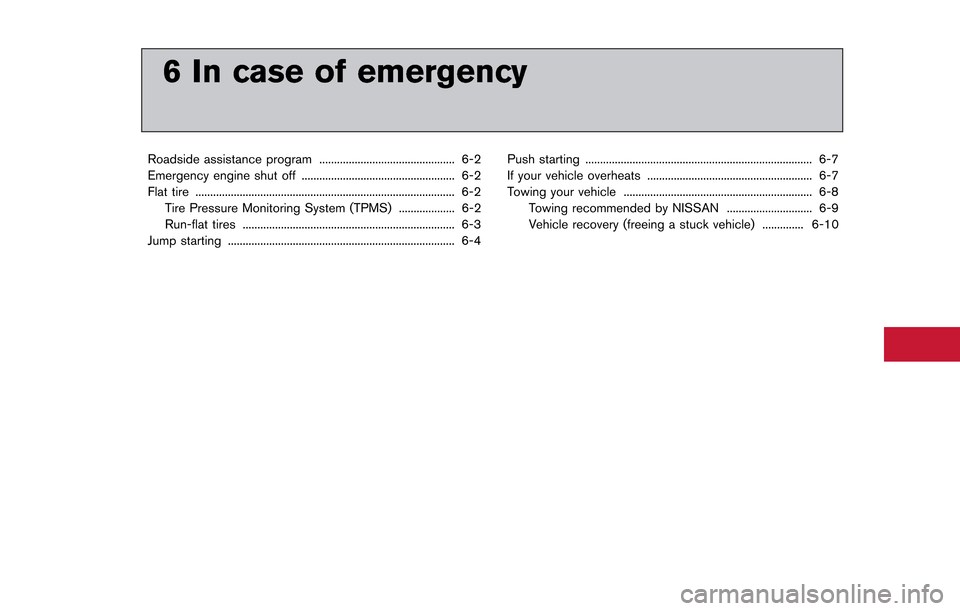
6 In case of emergency
Roadside assistance program .............................................. 6-2
Emergency engine shut off .................................................... 6-2
Flat tire ........................................................................\
................ 6-2Tire Pressure Monitoring System (TPMS) ................... 6-2
Run-flat tires ........................................................................\
6-3
Jump starting ........................................................................\
..... 6-4 Push starting ........................................................................\
..... 6-7
If your vehicle overheats ........................................................ 6-7
Towing your vehicle ................................................................ 6-8
Towing recommended by NISSAN ............................. 6-9
Vehicle recovery (freeing a stuck vehicle) .............. 6-10
Page 251 of 346
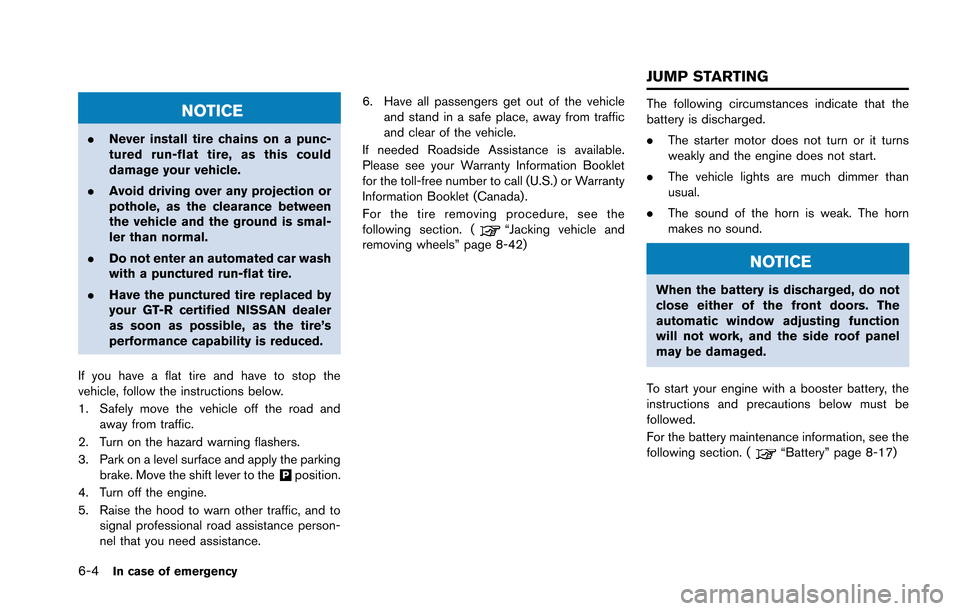
6-4In case of emergency
NOTICE
.Never install tire chains on a punc-
tured run-flat tire, as this could
damage your vehicle.
. Avoid driving over any projection or
pothole, as the clearance between
the vehicle and the ground is smal-
ler than normal.
. Do not enter an automated car wash
with a punctured run-flat tire.
. Have the punctured tire replaced by
your GT-R certified NISSAN dealer
as soon as possible, as the tire’s
performance capability is reduced.
If you have a flat tire and have to stop the
vehicle, follow the instructions below.
1. Safely move the vehicle off the road and away from traffic.
2. Turn on the hazard warning flashers.
3. Park on a level surface and apply the parking brake. Move the shift lever to the
&Pposition.
4. Turn off the engine.
5. Raise the hood to warn other traffic, and to signal professional road assistance person-
nel that you need assistance. 6. Have all passengers get out of the vehicle
and stand in a safe place, away from traffic
and clear of the vehicle.
If needed Roadside Assistance is available.
Please see your Warranty Information Booklet
for the toll-free number to call (U.S.) or Warranty
Information Booklet (Canada).
For the tire removing procedure, see the
following section. (
“Jacking vehicle and
removing wheels” page 8-42)
The following circumstances indicate that the
battery is discharged.
. The starter motor does not turn or it turns
weakly and the engine does not start.
. The vehicle lights are much dimmer than
usual.
. The sound of the horn is weak. The horn
makes no sound.
NOTICE
When the battery is discharged, do not
close either of the front doors. The
automatic window adjusting function
will not work, and the side roof panel
may be damaged.
To start your engine with a booster battery, the
instructions and precautions below must be
followed.
For the battery maintenance information, see the
following section. (
“Battery” page 8-17)
JUMP STARTING
Page 252 of 346

WARNING
.If done incorrectly, jump starting
can lead to a battery explosion,
resulting in severe injury or death.
It could also damage your vehicle.
. Explosive hydrogen gas is always
present in the vicinity of the battery.
Keep all sparks and flames away
from the battery.
. Do not allow battery fluid to come
into contact with eyes, skin, clothing
or painted surfaces. Battery fluid is
a corrosive sulphuric acid solution
which can cause severe burns. If the
fluid should come into contact with
anything, immediately flush the con-
tacted area with water.
. Keep the battery out of the reach of
children.
. The booster battery must be rated at
12 volts. Use of an improperly rated
battery can damage your vehicle.
. Whenever working on or near a
battery, always wear suitable eye
protectors (for example, goggles or
industrial safety spectacles) and remove rings, metal bands, or any
other jewelry. Do not lean over the
battery when jump starting.
. Do not attempt to jump start a
frozen battery. It could explode
and cause serious injury.
. Your vehicle has an automatic en-
gine cooling fan. It could come on at
any time. Keep hands and other
objects away from it.
If needed, Roadside Assistance is available.
Please see your Warranty Information Booklet
for the toll-free number to call (U.S.) or Warranty
Information Booklet (Canada).
In case of emergency6-5
Page 253 of 346
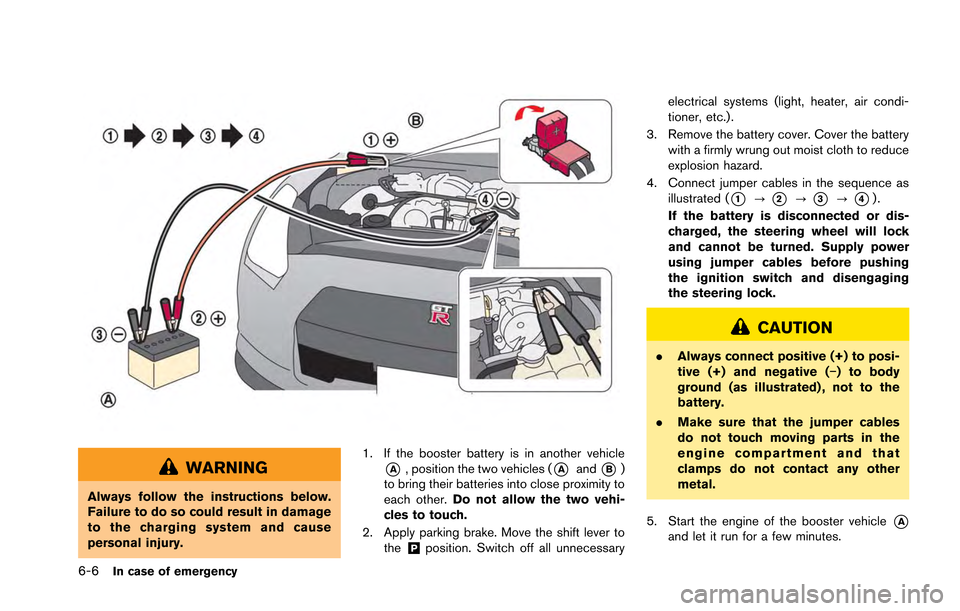
6-6In case of emergency
WARNING
Always follow the instructions below.
Failure to do so could result in damage
to the charging system and cause
personal injury.1. If the booster battery is in another vehicle
*A, position the two vehicles (*Aand*B)
to bring their batteries into close proximity to
each other. Do not allow the two vehi-
cles to touch.
2. Apply parking brake. Move the shift lever to the
&Pposition. Switch off all unnecessary electrical systems (light, heater, air condi-
tioner, etc.).
3. Remove the battery cover. Cover the battery with a firmly wrung out moist cloth to reduce
explosion hazard.
4. Connect jumper cables in the sequence as illustrated (
*1?*2?*3?*4).
If the battery is disconnected or dis-
charged, the steering wheel will lock
and cannot be turned. Supply power
using jumper cables before pushing
the ignition switch and disengaging
the steering lock.
CAUTION
. Always connect positive (+) to posi-
tive (+) and negative (−) to body
ground (as illustrated) , not to the
battery.
. Make sure that the jumper cables
do not touch moving parts in the
engine compartment and that
clamps do not contact any other
metal.
5. Start the engine of the booster vehicle
*Aand let it run for a few minutes.
Page 254 of 346
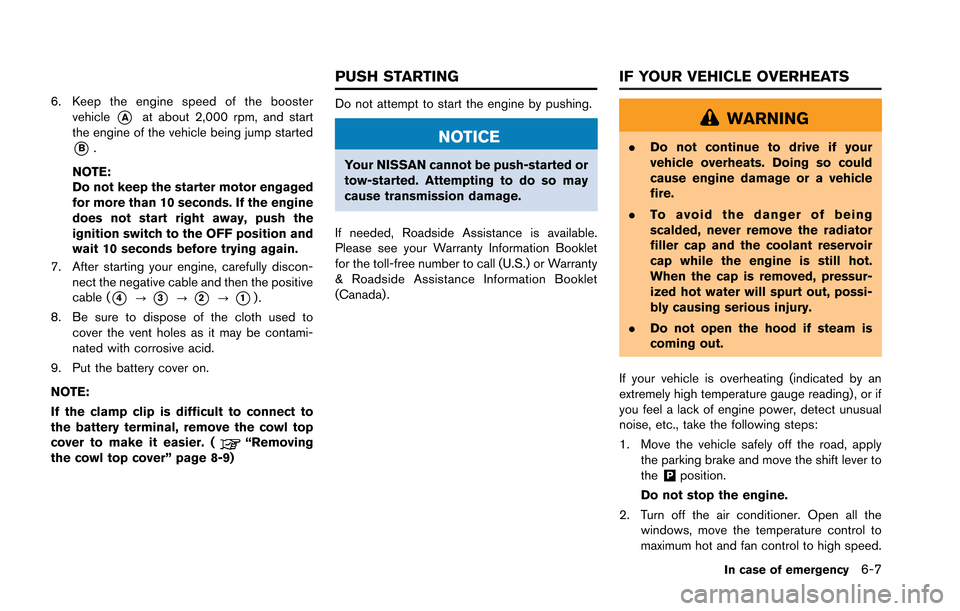
6. Keep the engine speed of the boostervehicle
*Aat about 2,000 rpm, and start
the engine of the vehicle being jump started
*B.
NOTE:
Do not keep the starter motor engaged
for more than 10 seconds. If the engine
does not start right away, push the
ignition switch to the OFF position and
wait 10 seconds before trying again.
7. After starting your engine, carefully discon- nect the negative cable and then the positive
cable (
*4?*3?*2?*1).
8. Be sure to dispose of the cloth used to cover the vent holes as it may be contami-
nated with corrosive acid.
9. Put the battery cover on.
NOTE:
If the clamp clip is difficult to connect to
the battery terminal, remove the cowl top
cover to make it easier. (
“Removing
the cowl top cover” page 8-9)
Do not attempt to start the engine by pushing.
NOTICE
Your NISSAN cannot be push-started or
tow-started. Attempting to do so may
cause transmission damage.
If needed, Roadside Assistance is available.
Please see your Warranty Information Booklet
for the toll-free number to call (U.S.) or Warranty
& Roadside Assistance Information Booklet
(Canada) .
WARNING
. Do not continue to drive if your
vehicle overheats. Doing so could
cause engine damage or a vehicle
fire.
. To avoid the danger of being
scalded, never remove the radiator
filler cap and the coolant reservoir
cap while the engine is still hot.
When the cap is removed, pressur-
ized hot water will spurt out, possi-
bly causing serious injury.
. Do not open the hood if steam is
coming out.
If your vehicle is overheating (indicated by an
extremely high temperature gauge reading) , or if
you feel a lack of engine power, detect unusual
noise, etc., take the following steps:
1. Move the vehicle safely off the road, apply the parking brake and move the shift lever to
the
&Pposition.
Do not stop the engine.
2. Turn off the air conditioner. Open all the windows, move the temperature control to
maximum hot and fan control to high speed.
In case of emergency6-7
PUSH STARTING IF YOUR VEHICLE OVERHEATS
Page 268 of 346
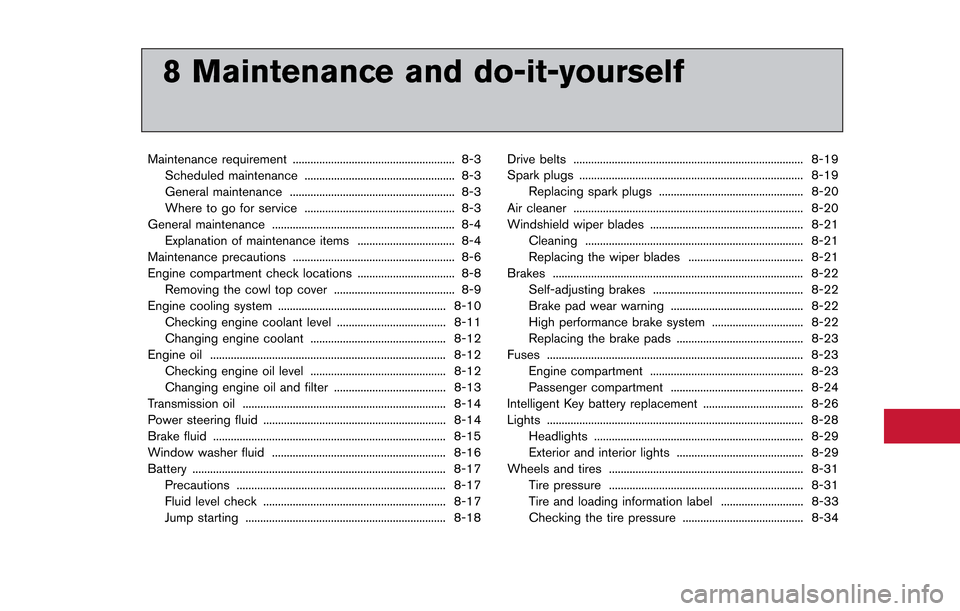
8 Maintenance and do-it-yourself
Maintenance requirement ....................................................... 8-3Scheduled maintenance ................................................... 8-3
General maintenance ........................................................ 8-3
Where to go for service ................................................... 8-3
General maintenance .............................................................. 8-4 Explanation of maintenance items ................................. 8-4
Maintenance precautions ....................................................... 8-6
Engine compartment check locations ................................. 8-8 Removing the cowl top cover ......................................... 8-9
Engine cooling system ......................................................... 8-10
Checking engine coolant level ..................................... 8-11
Changing engine coolant .............................................. 8-12
Engine oil ........................................................................\
........ 8-12
Checking engine oil level .............................................. 8-12
Changing engine oil and filter ...................................... 8-13
Transmission oil ..................................................................... 8-14
Power steering fluid .............................................................. 8-14
Brake fluid ........................................................................\
....... 8-15
Window washer fluid ........................................................... 8-16
Battery ........................................................................\
.............. 8-17
Precautions ....................................................................... 8-17
Fluid level check .............................................................. 8-17
Jump starting .................................................................... 8-18 Drive belts ........................................................................\
...... 8-19
Spark plugs ........................................................................\
.... 8-19
Replacing spark plugs ................................................. 8-20
Air cleaner ........................................................................\
...... 8-20
Windshield wiper blades .................................................... 8-21 Cleaning ........................................................................\
.. 8-21
Replacing the wiper blades ....................................... 8-21
Brakes ........................................................................\
............. 8-22 Self-adjusting brakes ................................................... 8-22
Brake pad wear warning ............................................. 8-22
High performance brake system ............................... 8-22
Replacing the brake pads ........................................... 8-23
Fuses ........................................................................\
............... 8-23
Engine compartment .................................................... 8-23
Passenger compartment ............................................. 8-24
Intelligent Key battery replacement .................................. 8-26
Lights ........................................................................\
............... 8-28 Headlights ....................................................................... 8-29Exterior and interior lights ........................................... 8-29
Wheels and tires .................................................................. 8-31
Tire pressure .................................................................. 8-31
Tire and loading information label ............................ 8-33
Checking the tire pressure ......................................... 8-34
Page 285 of 346

8-18Maintenance and do-it-yourself
Check the fluid level in each cell (Remove the
battery cover if it is necessary) . It should be
between the UPPER LEVEL
*1and LOWER
LEVEL
*2lines.
If it is necessary to add fluid, add only distilled
water to bring the level to the indicator in each
filler opening. Do not overfill.
1. Remove the cell plugs*A.
2. Add distilled water up to the UPPER LEVEL
*1line.
If the side of the battery is not clear, check
the distilled water level by looking directly
above the cell; the condition
*1indicates
OK and the conditions
*2needs more to
be added.
3. Tighten cell plugs
*A.
Vehicles operated in high temperatures or under
severe conditions require frequent checks of the
battery fluid level.
JUMP STARTING
If jump starting is necessary, see the following
section. (“Jump starting” page 6-4)
If the engine does not start by jump starting, the
battery may have to be replaced. Contact a
GT-R certified NISSAN dealer.
Page 339 of 346
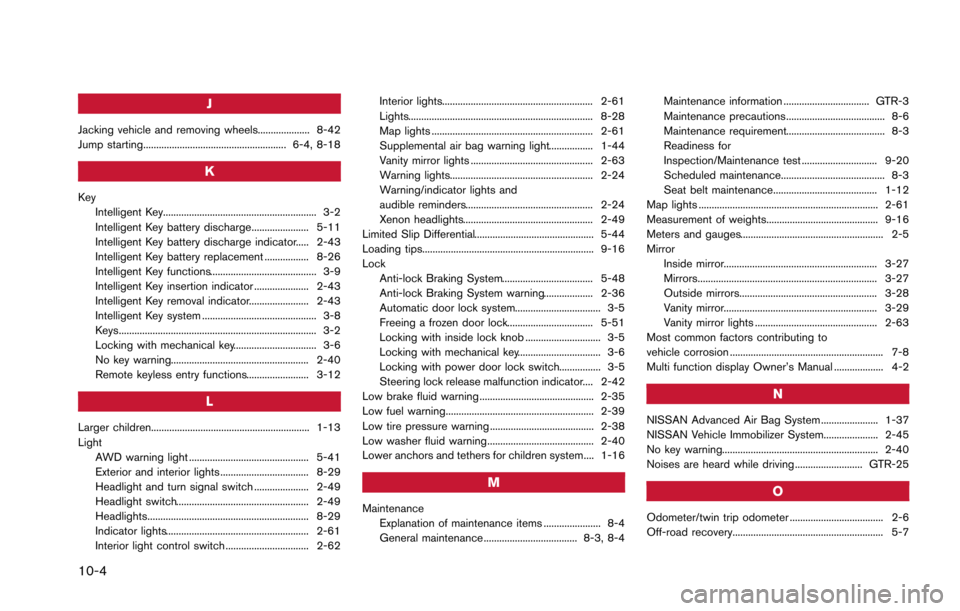
10-4
J
Jacking vehicle and removing wheels.................... 8-42
Jump starting....................................................... 6-4, 8-18
K
KeyIntelligent Key........................................................... 3-2
Intelligent Key battery discharge...................... 5-11
Intelligent Key battery discharge indicator..... 2-43
Intelligent Key battery replacement ................. 8-26
Intelligent Key functions......................................... 3-9
Intelligent Key insertion indicator ..................... 2-43
Intelligent Key removal indicator....................... 2-43
Intelligent Key system ............................................ 3-8
Keys............................................................................ 3-2
Locking with mechanical key................................ 3-6
No key warning..................................................... 2-40
Remote keyless entry functions........................ 3-12
L
Larger children............................................................. 1-13
LightAWD warning light .............................................. 5-41
Exterior and interior lights .................................. 8-29
Headlight and turn signal switch ..................... 2-49
Headlight switch................................................... 2-49
Headlights.............................................................. 8-29
Indicator lights....................................................... 2-61
Interior light control switch ................................ 2-62 Interior lights.......................................................... 2-61
Lights....................................................................... 8-28
Map lights .............................................................. 2-61
Supplemental air bag warning light................. 1-44
Vanity mirror lights ............................................... 2-63
Warning lights....................................................... 2-24
Warning/indicator lights and
audible reminders................................................. 2-24
Xenon headlights.................................................. 2-49
Limited Slip Differential.............................................. 5-44
Loading tips.................................................................. 9-16
Lock Anti-lock Braking System................................... 5-48
Anti-lock Braking System warning................... 2-36
Automatic door lock system................................. 3-5
Freeing a frozen door lock................................. 5-51
Locking with inside lock knob ............................. 3-5
Locking with mechanical key................................ 3-6
Locking with power door lock switch................ 3-5
Steering lock release malfunction indicator.... 2-42
Low brake fluid warning ............................................ 2-35
Low fuel warning......................................................... 2-39
Low tire pressure warning ........................................ 2-38
Low washer fluid warning......................................... 2-40
Lower anchors and tethers for children system.... 1-16
M
Maintenance Explanation of maintenance items ...................... 8-4
General maintenance .................................... 8-3, 8-4 Maintenance information ................................. GTR-3
Maintenance precautions...................................... 8-6
Maintenance requirement...................................... 8-3
Readiness for
Inspection/Maintenance test ............................. 9-20
Scheduled maintenance........................................ 8-3
Seat belt maintenance........................................ 1-12
Map lights ..................................................................... 2-61
Measurement of weights........................................... 9-16
Meters and gauges....................................................... 2-5
Mirror Inside mirror........................................................... 3-27
Mirrors..................................................................... 3-27
Outside mirrors..................................................... 3-28
Vanity mirror........................................................... 3-29
Vanity mirror lights ............................................... 2-63
Most common factors contributing to
vehicle corrosion ........................................................... 7-8
Multi function display Owner’s Manual ................... 4-2
N
NISSAN Advanced Air Bag System ...................... 1-37
NISSAN Vehicle Immobilizer System..................... 2-45
No key warning............................................................ 2-40
Noises are heard while driving .......................... GTR-25
O
Odometer/twin trip odometer .................................... 2-6
Off-road recovery.......................................................... 5-7